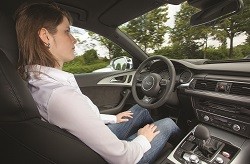Putting automated technologies in the driving
The successes of this project will now feed into a hugely ambitious EU-funded pilot project set to start this autumn. This will further advance European expertise in understanding how automated vehicles can be effectively integrated into Europe’s transport infrastructure. Human-inspired technology A key objective of the ADAPTIVE project was to highlight the importance of the human factor in any automated solution. ‘We have to accept that we will be dealing with human drivers for quite some time,’ says ADAPTIVE project coordinator Aria Etemad from Volkswagen Group Research. ‘We therefore need to make vehicles more intelligent in terms of sensing their environment, but make sure that this merges with the intelligence of the driver.’ This concept influenced the type of innovations that were tested, and a code of practice that takes into account the human factor has been put together. This step-by-step guide on how to design an automated system will now be taken forward in future EU-funded initiatives. The project advanced the technical side of vehicle automation by testing combinations of sensors: ultrasonic cameras, radars, and laser scanners. Etemad and his team sought to harness the ability of automation to perform tasks that could make driving safer. For example, information from the tail end of a traffic jam could be sent to vehicles coming up a few minutes behind, helping to reduce congestion and limit the possibilities of accidents. ‘General scenarios we trialled included low speed parking scenarios, mid-speed urban driving and high speed motorway driving up to 130kmh,’ he explains. ‘One scenario we were interested in was vehicles merging onto motorways. We demonstrated how a truck travelling along the motorway can communicate with a car trying to enter the motorway from a slip road in order to create enough space, and vice versa.’ The project also investigated how a rescue tunnel could be created to allow emergency vehicles to pass. Long-term planning Another key element in which the project has delivered tangible results is in developing new methods for test and evaluation. ‘This is hugely important moving forward,’ says Etemad. ‘In order to develop new solutions for, say, adaptive cruise control, you need to test drive up to 2m kilometres. For automated driving solutions, you might need to drive up to 100m kilometres in order to get approval. This is clearly not affordable, so we have identified possible simulation software that might help industry.’ ADAPTIVE also identified certain legal aspects – such as the 1968 Vienna Convention – which need to be reformed. This convention stipulates that drivers must be continuously in control of their vehicle. Adaption and harmonisation of legal infrastructure is vital to allow automated vehicles onto the road in the first place. The results of this ground breaking 42-month project, due for completion in June 2017, will now be used in in the forthcoming L3PILOT project. This initiative will test 100 automated vehicles in 12 European countries, and is the largest EU-funded project of its kind. ‘There is still a lot of work to be done,’ says Etemad. ‘We need to test sensors in critical situations, for example radars in snow and cameras in fog.’ Through a careful examination of the legal, technical, human and economic issues that surround automated transport, the ADAPTIVE project has achieved an excellent overview of the challenges facing automated mobility. The goal now is to build on this work in order to push the sector ever closer towards commercialisation.
Keywords
ADAPTIVE, transport, automotive, robotic, safety, Volkswagen, urban, mobility, automation, L3, HMI, liability, motorway, sensor, radar, lidar, perception, parking







